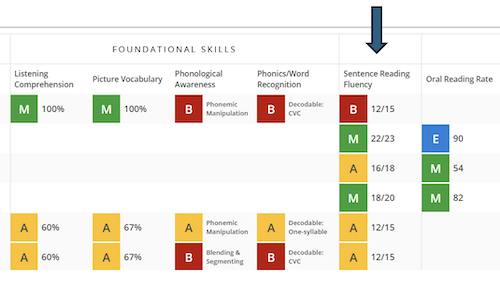
Alexander Graham Bell once said, “Before anything else, preparation is the key to success.” I couldn’t agree more. When reflecting on MAP partners I have gotten to work with, one thing has become abundantly clear: districts, campuses, and educators with seemingly high implementation success have a clear, streamlined process in place that does not leave room for misconceptions. I want your school or district to have high implementation success, too, so I’d like to share some MAP testing tips for assessment in the fall and beyond.
Below, you will find four specific tips that can help:
- Know your why for MAP testing
- Share your why with all stakeholders
- Make a plan for implementation
- Ask the questions each group of stakeholders should be able to answer
Tip #1: Know your why for MAP testing
One of the first questions I encourage you to ask yourself is your why for utilizing MAP. Whether you’re testing with MAP® Growth™, MAP® Reading Fluency™, or both, please take a moment to jot this why down.
Did identifying your why come easily, or are you unsure? It’s okay either way. Write down whatever comes to mind because that will provide a good starting point. If you remain unsure of your why after spending some time with what you wrote down, I encourage you to seek out clarity by asking a colleague (or a few).
There are various reasons for using MAP testing to support teaching and learning. Here are several whys shared by some districts I’ve worked with:
- Monitors the progress of all student learning over time, allowing for proactive intervention and celebration of learning
- Offers opportunities to differentiate classroom instruction based on specific student need
- Creates a culture for continuous improvement district wide
- Provides all stakeholders with data that can inform plans to increase achievement for all students
- Allows for data conversations with students to identify areas of strength and opportunities for growth, creating opportunities to work with students to set goals
- Connects to instructional connections to meet needs for students and potentially leverage additional supplemental resources
Tip #2: Share your why with all stakeholders
Once you’ve identified your MAP testing why, how will you communicate it to colleagues, students, and caregivers? Stakeholders are not simply educators and students; we must leverage the expertise and desire of caregivers and allow the community to get involved, too. Knowledge is power, and that power can be harnessed through communication.
NWEA offers a Family Toolkit that includes videos, guides, and more designed to help caregivers make sense of MAP Growth. We also have several blog posts with advice on supporting families.
Prior to sharing the Family Toolkit with caregivers, campus leaders and educators must be on the same page and speaking the same language about MAP. This allows us to have consistent conversations with students. To do so, you may need to firm up your own understanding of MAP products. Spend some time with the toolkit yourself so you can better understand MAP assessments, how to communicate with families, and tools and strategies to implement after students have tested. Your contact at NWEA can help you with all of this as well.
Ideally, sharing your why with stakeholders will make it so much easier to use assessment data to create meaningful learning opportunities for students and to see MAP data as one point in the larger picture, that is, as data to analyze in conjunction with other information you have about students, from teacher observations to attendance records.
How will you get all stakeholders to understand your why for MAP testing? How will you get them to see it is not something we simply do three times a year and then forget? How can you support students in becoming investors in their own learning journey and thinking about what growth means to them?
Tip #3: Make a plan for implementation
Now that you have the why behind using MAP jotted down and have decided on the best way to share that why with stakeholders, you’re ready to think about implementation.
When implementing an assessment like MAP Growth or MAP Reading Fluency in a district, campus, or classroom, making plans can increase the likelihood of follow-through for two primary reasons: 1) creating plans encourages people to develop strategies for overcoming obstacles ahead of time, before those obstacles are reached, and 2) according to many researchers, including Gavan Fitzsimons and Vicki Morwitz, plan-making helps on a cognitive level, forging links in the memory between future moments (like testing day) and the behaviors required to be ready for those moments.
When we create plans for administering assessments, we are ensuring everyone agrees and is ready to move forward together. If we don’t properly plan for MAP testing, multiple grade levels may decide to test at the same time, for example. If your district or campus isn’t one-to-one with devices, that may create a problem. If teachers who are acting as proctors are not prepared, the wrong test could be assigned, accommodations may or not be assigned, and more. All teachers—plus leaders, students, and caregivers—benefit from having a plan in place.
If proctors have a plan explaining when they are to assign the test to students, they can plan accordingly with less pressure and stress. When proctors and other teachers understand what MAP Growth and MAP Reading Fluency are, as well as their intended uses, they can have more meaningful conversations with students to create understanding. If all educators in a building understand how MAP data can and will be used, they can have more collaborative discussions about academic opportunities. This can help ensure students are offered opportunities for Tier 1 instruction with rigor and fidelity while putting scaffolds and/or extensions in place as needed. When students and their families understand what the assessments are and how they are used, they can become partners with teachers, working to create meaningful goals and fostering self-efficacy, among other things.
Tip #4: Ask the questions each group of stakeholders should be able to answer
This brings me to the various questions everyone in your school community should be able to answer about MAP Growth and MAP Reading Fluency. Think of this as a quality assurance check to ensure the other tips were executed effectively. If any of your stakeholders can’t answer some of these questions, how can you help them better understand your why or your implementation plan?
Campus leaders
- Why are we using MAP Growth and/or MAP Reading Fluency?
- When is the testing window?
- What grade levels and subjects will be given what assessment?
- Are we altering the bell schedule and shutting down the campus on testing day, or will educators test within their class time?
- Who should proctors reach out to if they need support during testing?
- Is there a retesting policy?
- What are the intended uses of the assessment data?
- How will we analyze the data?
- When will we analyze the data?
- What are the expectations and what time allotments will be given to educators to dig into the data?
- How will we communicate the intentions behind the assessment to teachers, students, and caregivers?
Teachers, including proctors
- Why are we using MAP Growth and/or MAP Reading Fluency?
- When is the testing window?
- What assessment is to be given, to which students, and when?
- How do I proctor?
- Who do I reach out to for support?
- What do I do if I feel a student should be retested?
- What should I tell students about MAP before testing day?
- When will I analyze the assessment data?
- What should I do with the assessment data?
Students
- Why am I taking MAP Growth and/or MAP Reading Fluency?
- Is this for a grade? If not, why is it important that I do my best?
- How will my scores be used?
- How can I create goals for my learning based on my scores?
Caregivers
- What is MAP Growth and/or MAP Reading Fluency?
- How is MAP Growth and/or MAP Reading Fluency different from other assessments?
- Are there resources for families?
- When will results be communicated to caregivers?
As you think about the many stakeholders involved, how comfortable do you feel preparing them to answer these questions? Are there any you want to seek clarification on before you begin testing? Even if you have already completed testing for your district or campus, do you need to go back and provide any guidance for stakeholders?
In conclusion
Educators are brilliant humans, capable of creating innovative lessons, building relationships, and adapting endlessly. If we can take a little time to prepare ourselves and each other ahead of MAP testing, we can all gain the confidence needed to succeed. And confidence can be contagious for students.
When our students have a sense of ownership and personal power, they become empowered learners. And isn’t that what we all want most?






